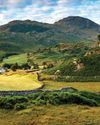With British-made slippers enjoying an upturn in sales, Matthew Dennison discovers why now’s the perfect time to slip into something more comfortable

IN 1829, the editor of The Edinburgh Literary Journal offered his readers an encomium on the subject of slippers. ‘Without slippers, winter would be merely a season of greatcoats and sore throats;—without slippers summer would be nothing but a few months of perspiration and white trousers… To winter, slippers impart all its fireside comfort,—to summer all its refreshing coolness.’ On the evidence of a recent upturn in slipper sales reported by leading British manufacturers, it’s a view that continues to win adherents.
Happily, both for the sartorially discerning and those with an interest in the well-being of Britain’s traditional shoemakers, the slippers currently enjoying a particular vogue are made in this country, from velvet, with quilted-satin linings and leather soles and heels, cut and lasted by hand using traditional techniques. And at Crockett & Jones and Oliver Brown, there is even a consensus among customers about the colour of the moment: navy blue, most often without monogramming or embroidered decoration.
At Oliver Brown, Kristian Robson attributes the resurgence in popularity of this highly traditional piece of men’s footwear to the continuing impact of Downton Abbey, with its focus on luxurious formal clothing, but it’s also the case that velvet slippers have lately made their way on to international catwalks, showcased by designers such as Prada. As Jason Simmonds of Devon-based shoemakers Herring tells me, the slippers in question—laceless, pull-on, tab-fronted designs—are more accurately described as ‘house shoes’ ‘as they have the same lasted shape, toe and heel shapers that a welted shoe would have, but with a much thinner sole and luxurious velvet uppers’.
Diese Geschichte stammt aus der November 8, 2017-Ausgabe von Country Life UK.
Starten Sie Ihre 7-tägige kostenlose Testversion von Magzter GOLD, um auf Tausende kuratierte Premium-Storys sowie über 8.000 Zeitschriften und Zeitungen zuzugreifen.
Bereits Abonnent ? Anmelden
Diese Geschichte stammt aus der November 8, 2017-Ausgabe von Country Life UK.
Starten Sie Ihre 7-tägige kostenlose Testversion von Magzter GOLD, um auf Tausende kuratierte Premium-Storys sowie über 8.000 Zeitschriften und Zeitungen zuzugreifen.
Bereits Abonnent? Anmelden

Shhhhhh...
THERE is great delight to be had poring over the front pages of COUNTRY LIFE each week, dreaming of what life would be like in a Scottish castle (so reasonably priced, but do bear in mind the midges) or a townhouse in London’s Eaton Square (worth a king’s ransom, but, oh dear, the traffic) or perhaps that cottage in the Cotswolds (if you don’t mind standing next to Hollywood A-listers in the queue at Daylesford). The estate agent’s particulars will give you details of acreage, proximity to schools and railway stations, but never—no, never—an indication of noise levels.

Mission impossible
Rubble and ruin were all that remained of the early-19th-century Villa Frere and its gardens, planted by the English diplomat John Hookham Frere, until a group of dedicated volunteers came to its rescue. Josephine Tyndale-Biscoe tells the story

When a perfect storm hits
Weather, wars, elections and financial uncertainty all conspired against high-end house sales this year, but there were still some spectacular deals

Give the dog a bone
Man's best friend still needs to eat like its Lupus forebears, believes Jonathan Self, when it's not guarding food, greeting us or destroying our upholstery, of course

Shake your pompom
Some can rock a bobble hat, others will always resemble Where's Wally, but still this knitted creation belongs on every hat rack, says Harry Pearson

Where time stands still
Memorials are our nation’s collective memory, built to endure and ensure that achievements, individuals and disasters are never forgotten. Susan Owens takes an emotive tour around the British Isles in 50 monuments

'Eating is an agricultural act'
Farmers need to convince consumers that the choices they make are integral to preserving the British environment

Welcome home
Despite the trundling tractor and buzzing shears, our ancestors would still recognise the rhythm, ritual and practices of the traditional hill farm, argues John Lewis-Stempel

When the saints march in The Cathedral and Abbey Church of St Albans, Hertfordshire, part II
In the second of two articles, John Goodall examines some of the recent changes made to highlight the saints associated with this ancient church

All gone to pot
Jars, whether elegant in their glazed simplicity or exquisitely painted, starred in London's Asian Art sales, including an exceptionally rare pair that belonged to China's answer to Henry VIII